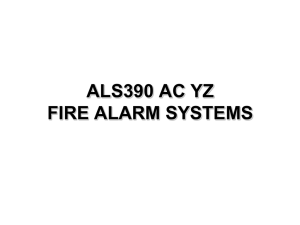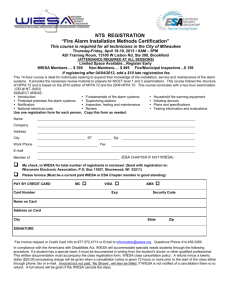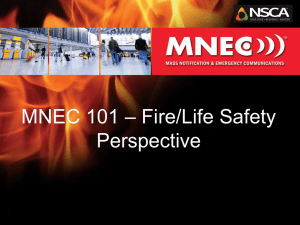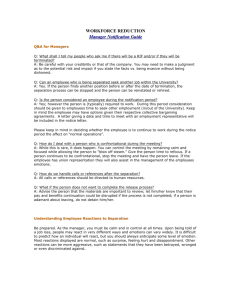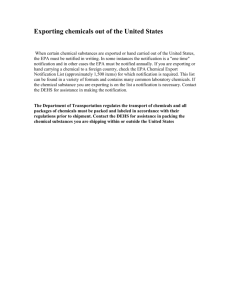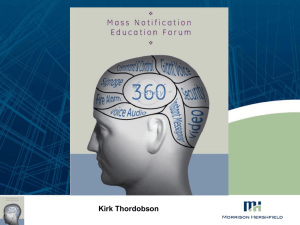Mass Notification Systems - Canadian Fire Alarm Association
advertisement
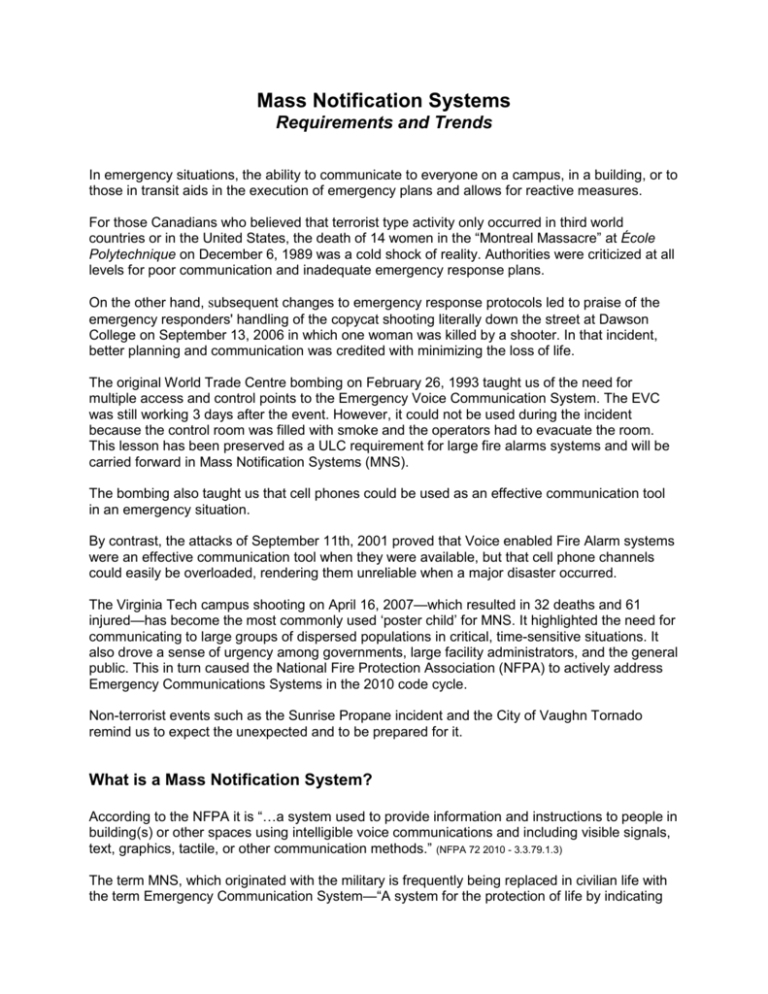
Mass Notification Systems Requirements and Trends In emergency situations, the ability to communicate to everyone on a campus, in a building, or to those in transit aids in the execution of emergency plans and allows for reactive measures. For those Canadians who believed that terrorist type activity only occurred in third world countries or in the United States, the death of 14 women in the “Montreal Massacre” at École Polytechnique on December 6, 1989 was a cold shock of reality. Authorities were criticized at all levels for poor communication and inadequate emergency response plans. On the other hand, subsequent changes to emergency response protocols led to praise of the emergency responders' handling of the copycat shooting literally down the street at Dawson College on September 13, 2006 in which one woman was killed by a shooter. In that incident, better planning and communication was credited with minimizing the loss of life. The original World Trade Centre bombing on February 26, 1993 taught us of the need for multiple access and control points to the Emergency Voice Communication System. The EVC was still working 3 days after the event. However, it could not be used during the incident because the control room was filled with smoke and the operators had to evacuate the room. This lesson has been preserved as a ULC requirement for large fire alarms systems and will be carried forward in Mass Notification Systems (MNS). The bombing also taught us that cell phones could be used as an effective communication tool in an emergency situation. By contrast, the attacks of September 11th, 2001 proved that Voice enabled Fire Alarm systems were an effective communication tool when they were available, but that cell phone channels could easily be overloaded, rendering them unreliable when a major disaster occurred. The Virginia Tech campus shooting on April 16, 2007—which resulted in 32 deaths and 61 injured—has become the most commonly used ‘poster child’ for MNS. It highlighted the need for communicating to large groups of dispersed populations in critical, time-sensitive situations. It also drove a sense of urgency among governments, large facility administrators, and the general public. This in turn caused the National Fire Protection Association (NFPA) to actively address Emergency Communications Systems in the 2010 code cycle. Non-terrorist events such as the Sunrise Propane incident and the City of Vaughn Tornado remind us to expect the unexpected and to be prepared for it. What is a Mass Notification System? According to the NFPA it is “…a system used to provide information and instructions to people in building(s) or other spaces using intelligible voice communications and including visible signals, text, graphics, tactile, or other communication methods.” (NFPA 72 2010 - 3.3.79.1.3) The term MNS, which originated with the military is frequently being replaced in civilian life with the term Emergency Communication System—“A system for the protection of life by indicating the existence of an emergency situation and communicating information necessary to facilitate an appropriate response and action.” (NFPA 72 2010 - 3.3.79) Effective Emergency Communications In order to be effective, Emergency Communications must: Inform or Notify – Target population and key personnel are alerted to WHAT is happening and WHERE it is occurring Provide Instruction – Notification is only effective if it gives direction on how to act or what to do Verify – Critical communications require verification that messages are heard, understood and acted upon. Repeat – Most people need to hear a message 3 times before they react to it. Truly effective communication is about more than getting the message out. It’s about ensuring the message gets through. So no matter where people are, you need to reach them all. There are 4 Tiers of Mass Notification Systems: 1. Immediate and intrusive alerting (Sirens, Fire Alarm Voice Evac. or Electronic Signs) 2. Personal alerting (SMS, Cell Phones E-mail) 3. Public alerting (Radio, TV) 4. Locally relative alerting (Bull Horns) You should include at least 2 forms of communication, one from Tier 1 and a secondary method from one of the other Tiers to provide a reliable and robust solution. You should also maximize “contact potential” by layering communications which employ multiple technologies and communication modalities. Mass Notification Activity Everybody’s talking about Mass Notification, but what is actually happening in the “real” world? Customers Today’s owners and facility managers must balance multiple conflicting pressures. First there is the traditional mission to provide a safe work, learning, and/or living environment. This must be balance against fiscal responsibility and budget constraints. Tragic events such as 911 and Virginia Tech lead to political pressure, stakeholder concerns, and public relations nightmares, as well as liability concerns and risk management issues. Whether it is the safety of businesses and buildings from terrorism or the safety of young people and educators, there is a resounding call for owners and managers to develop an Emergency Response Plan and install a mass-notification system (MNS) in our facilities and campuses now. And they must do so in within the confines of Code compliance and enforcement. Industry Providers Evolving discussion amongst industry providers continues to define the market. Potential providers are examining the market and positioning their respective offerings to take advantage of what appears to be a huge and growing market. Mergers, acquisitions, and strategic partnerships are common. Some companies are leading with their particular product or strength. For example, Fire alarm companies presenting a fire alarm solution Security companies presenting a security solution Communication companies presenting a communication solution Technology companies approaching solely as integrators Some are opportunistically entering the market and looking to make a quick profit, As the market continues to evolve, few companies will be long-term players. Some large companies will revisit strategic priorities and decide that MNS will not fit over time. Others will find that the cost and complexity of agency approvals are prohibitive. Some small companies may simply not be around or may be acquired by larger ones. Regulatory Agencies Unified Facilities Criteria (UFC 4-021-01) The Unified Facilities Criteria was one of the first MNS standards. The US Department of Defense (DOD) developed UFC 4-021-01 specifically to address terrorist events on U.S. military bases in the aftermath of the Khobar Tower truck bombing in Saudi Arabia on June 25, 1996. Although a useful reference document, it has no legal jurisdiction in Canada. Underwriters Laboratory (UL) As Industry Providers began presenting MNS solutions to customers, customers responded by asking for some proof of performance, such as the UL mark on Fire Alarm systems. Unfortunately, there were no standards in place to which approval agencies could test and list products. UL2572 Control and Communication Units for Mass Notification Systems In response to industry and public need for a MNS equipment listing, UL created a bench standard and issued it as an interim listing (August 2008). Originally, this was intended as a set of requirements for connecting an external audio input to a Fire Alarm System. A bench standard is only supposed to have a life span of two years. A Standards Technical Panel (STP) was therefore formed to create a formal document with a target date of June 2009. The STP is made up of 29 “industry” representatives that include Fire Alarm manufacturers, sound system manufacturers, fire protection and electrical engineers, and government and fire department officials. The document was then issued for public review. At the same, in the spirit of harmonization, UL invited ULC to appoint a “guest” member to the STP. This person was expected to follow up by leading in the creation of a (hopefully harmonized) Canadian version. As a result of the public review, the scope of the UL document expanded and now includes: In-building Mass Notification System Wide-area Mass Notification System Distributed Recipient Mass Notification System Targeted Recipient Equipment Software Interfaces Combination Systems The target for completion is currently unknown but is expected to be late 2010 or possible early 2011. Underwriters’ Laboratories of Canada (ULC) The ULC Committee on Fire Alarm & Life Safety Equipment and Systems (ULC S500F) responded to the UL invitation by accepting a New Work Item proposal for the creation of ULC S576 - Mass Notification System Communication and Control Units at their annual meeting in May, 2009. A new Working Group was formed under the Sub-committee on Control Panels, and a Working Group chair/representative to STP 2572 was appointed. Work on creating S576 will begin when the dust settles on UL2572. It is expected that the standards used to evaluate Fire Alarm signalling devices will also be used to evaluate Mass Notification devices. As a result, there will be some changes to: CAN/ULC S525 Audible Signals for Fire Alarm Systems CAN/ULC S526 Visible Signals for Fire Alarm Systems CAN/ULC S541 Speakers for Fire Alarm Systems Mass Notification systems will also be expected to be installed and tested to the same level of reliability and integrity as Fire Alarm systems. As a result, there will probably be changes to: CAN/ULC S524 Installation of Fire Alarm Systems CAN/ULC S536 Inspection and Testing of Fire Alarm Systems CAN/ULC S537 Verification of Fire Alarm Systems ULC S573 Installation of Ancillary Devices National Building Code of Canada The 2010 edition of the National Building Code of Canada (NBC) will be published in November 2010. Several changes related to fire alarm and life safety systems were developed for the 2010 codes. However, Mass Notification Systems were not included in these changes. Updates to the national codes occur continuously with annual public reviews. Work on the next cycle of changes has already commenced and the topic of Mass Notification Systems (MNS) is on the agenda of the technical committees. Frequently, when code developers start working on a new cycle, they begin by looking at what has been published by other national and international organizations such as the National Fire Protection Association (NFPA), European Standards, etc. It is therefore reasonable to expect that many of the changes to the NBC regarding MNS will be based on the requirements found in NFPA 72 2010. NFPA 72 2010 To understand the full breadth of the design and applications details within this new edition would require days of training. Chapter 24 Emergency Communication Systems Generally, it embraces a broad ‘All Hazards Approach’ to addressing emergency communication, which includes but is not limited to fire, terrorist activities, other dangerous situations, accidents, and natural disasters. It requires “intelligible” voice messages. Mass notification messages are allowed to over-ride fire alarm notification if supported by the Risk Analysis and approved by the Authority Having Jurisdiction (AHJ). (A major variation from UFC requirements) Chapter 24 Emergency Communication Systems Chapter 24 emphasizes performance-based design, which is something the NBC began in the 2005 edition. It also emphasizes survivability of the system, something the Canadian Fire Alarm codes and standards have also been doing for years. Ancillary functions—including the use of the system for general paging, and other nonemergency functions—are permitted provided they don't interfere with emergency performance requirements. In fact, the re-use of existing systems is encouraged, provided they meet the performance and survivability requirements of the Risk Analysis and the approval of the AHJ. In addition to updated requirements for in-building fire emergency voice/alarm systems, this new chapter includes first-time provisions for: In-building MNS Wide-area MNS for locations such as college campuses Distributed recipient MNS to communicated with targeted individuals or groups Risk analysis requirements for the design of MNS In-Building Mass Notification Systems In-Building MNS consist of equipment and systems that are normally found inside buildings such as: Fire voice speakers Flat panel displays LED displays PA / Intercom Network PCs Phone Systems Wired and wireless buttons Indoor camera systems Wide Area Mass Notification Systems Wide Area MNS consist of equipment and systems that are normally found outside buildings such as: Sirens Outdoor PA systems High-power speaker array “Giant Voice” systems Outdoor strobes Electronic signage Emergency call stations Outdoor camera systems Distributed Recipient Mass Notification Systems (DRMNS) Distributed Recipient MNS systems consist of equipment and systems that are normally found at your side, such as: Pagers Cell phones / Smart phones Personal E-mails IM (Instant Message) Alerts Duress Alarms Hand-held Radios Mass dialing systems Computer pop-ups Sending emergency alerts via SMS text messages to cell phones has gained a lot of traction on campuses this past year. Additionally, text messages can travel far beyond campus boundaries. Just like other mass notification methods, text messaging shouldn’t be relied on as the only way a campus meets its emergency notification needs. This solution, although valuable, also has its limitations. “I got the emergency text message 2 days later” It is important to understand how the messaging systems work and the different levels of communication. Level 1: Lowest Level of Priority, Service and Security (“Send and Pray”) (Mobile Text Messaging, Wireless Text Messaging) This is not technically “true” Short Message Service (SMS). It is basically email to mobile devices. It is only 1-way and there are delivery delays, security issues, spam conflicts, and server congestion. Often offered for “free,” it should not be relied on for emergency situations Level 2: Medium Level of Priority, Service and Security (SMS device to SMS device) This is 2-way messaging and offers an improvement in delivery and security over Level 1. It is Retail level technology and is used for messaging between friends and relatives. Most Messaging companies do not use level 2, instead relying on Level 1 Level 3: Highest Level of Priority, Service and Security (Commerce Transactions) For MNS, you must insist on this level of priority. Speed, accuracy, and reliability are of utmost importance for carriers offering these services. Highest care is taken to ensure that messages get through. Services include 1-to-many and 2-way. It is a premium cost service and is mostly offered as a subscription. Level 3 messages have delivery priority over Levels 1 and 2. There are, of course, other issues. Third-party servers may categorize the messages as spam, for example. Additionally, even if the message gets through to the recipient’s inbox, there is no guarantee he or she will open the message in a timely fashion (or at all). The intended recipient might be away from his or her cell phone or pager for some reason. Finally, some conspiracy theorists predict that, in the event of another terrorist attack, the authorities will cut off everyone’s ability to use cell phones, blackberries, etc. This is because cellular is the preferred communication source used by terrorists and is often the way that bombs are detonated. Whether you believe this theory or not, SMS should not be relied on as the only way to meet its emergency notification needs. Messages, regardless of whether they are Inside, Outside or At Your Side should provide the following content: Information on the hazard and the danger Guidance on what people should do (leave or take cover) Description of the location of the risk or hazard An idea of when they need to act (immediately or within the hour) The name of the source of the warning (who is issuing) Risk Analysis for Mass Notification Systems Each application of a mass notification system should be specific to the nature and anticipated risks of each facility for which it is designed. It should consider both fire and non-fire emergencies. It should result in a performance-based design and risk analysis that becomes the basis for the development of the Emergency Response Plan Some of the Basic Questions that should be addressed as part of the analysis (A 24.4.2.2.1) include: 1. What is the type of the emergency event? 2. What is the urgency of the emergency event? 3. What is the anticipated or expected severity of the emergency event? 4. What is the certainty of the event (past, present, future or unknown)? 5. What is the location of the event or from what direction? 6. What zones or areas should receive the emergency message(s)? 7. What is the validity of emergency event? 8. What instructions should be sent? 9. Are there any special instructions, procedures, or special tasks to be accomplished (e.g. close doors, stay away from windows, and do not use elevators)? A defense of “…nothing could have been done to prevent what happened” at Virginia Tech resulted in an $11 million class action wrongful death judgment against the State of Virginia with 2 more suits approved to proceed. Today, organizations are expected to anticipate the unexpected. Emergency Response Plan Elements NFPA recommends that the Emergency Response Plan be designed in accordance with NFPA 1600 Standard on Disaster / Emergency Management and Business Continuity Programs and NFPA 1620 Recommended Practice for Pre-Incident Planning. It should include specific details on the: Emergency response team structure Emergency response procedure Emergency response equipment and operations Emergency response notification Emergency response training and drills Emergency Response Planning Process Gather information on existing procedures, personnel equipment Identify specific needs Anticipate the unexpected Gap analysis: Desired versus Current state Consider the cost of doing nothing Prioritize plan execution (customer specific concerns determine levels of priority): Immediate Needs (Now) Short-Term (6-18 months) Long-Term (2-5 years) On-going review and revision of plan over time Process requires long-term vision and planning Challenges The challenges in designing and installing a successful Mass Notification System are not in the technology. Challenges include: Identifying the decision makers in a facility Getting buy-in from all stakeholders Threat assessment Emergency action planning Financial impact (budgeting) Phased implementation (master planning) Ongoing evaluation (perpetual integration) Long term support (i.e. will the supplier still be here 5 years from now?) For additional information Additional information on Mass Notification Systems can be found in: National Fire Protection Association http://www.nfpa.org Or Annex Publishing and Printing http://www.annexbookstore.com NFPA 72 NFPA 1600 NFPA 1600 NFPA 1620 National Fire Alarm and Signaling Code (2010) Standard on Disaster / Emergency Management and Business Continuity Programs implementing National Preparedness Standard Recommended Practice for Pre-Incident Planning Campus Safety Magazine http://www.campussafetymagazine.com Manufacturers Web Sites Wherever large groups of people can be found—such as Hospitals, Colleges and Universities, and Industrial complexes; those responsible for providing a safe work environment need to be prepared to respond to a myriad of crises, including violence, natural or man-made disasters, fires, electrical failures, and more. A mass notification system is a fundamental tool in enabling quick and effective response to any emergency. Remember to focus not on the tool, or the toys, but on the purpose: Reach them all! Author: Donald Boynowski is the Product Manager for Siemens Building Technologies, Ltd., Fire Safety Division. A Certified Engineering Technologist and a CFAA registered Fire Alarm Technician, Don has over 30 years experience in the fire alarm industry. Don is a voting member of the ULC Committee on Fire Alarms Equipment and Systems and serves on various SubCommittees and Working Groups. He is also Canadian Co-Chair of the NEMA ULC/UL Technical Harmonization Committee for Notification Appliances. Don represents ULC on the UL Standards Technical Panel for Mass Notification Control Units (UL2572) and will chair the working group that will create the Canadian version, ULC-S576.
